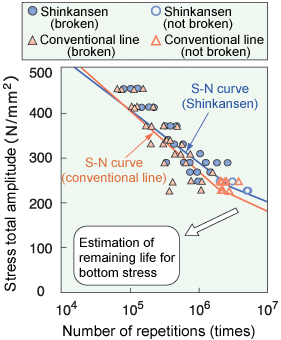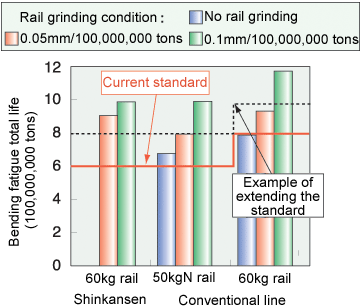| 6. Method of Evaluating the Lifespan of Aging Rails | |||
|
The replacement period for each type of long rail is specified based on the passing tonnage. The possibility of extending the replacement period was suggested after performing fatigue tests on the weld zones of new 50kgN and 60kg rails and estimating their lifespan. In this study, the S-N curve as shown in Fig.1 was obtained by collecting data and performing fatigue tests on aging rails, focusing on the rail weld zones of commercial lines with an accumulated passing tonnage of between 140,000,000 and 800,000,000 tons. This S-N curve takes aging history into account and represents the remaining life after the passing tonnage exceeds 380,000,000 tons for Shinkansen rails and 540,000,000 tons for conventional line rails. The results of estimating the remaining life using this S-N curve verified that, as shown in Fig.2, the rail replacement period can be extended by about 200,000,000 tons after rail grinding of 0.1mm/100,000,000 tons. For underwater tunnels whose environment accelerates corrosion, the replacement period is based on the number of years elapsed. Corroded rails from underwater tunnels were therefore collected, fatigue tests were performed and an S-N curve by maximum irregularity on the rail bottom was estimated. Based on the test results, the possibility of extending the replacement period was suggested after examining the relationships between the level of corrosion and the remaining life.
|

